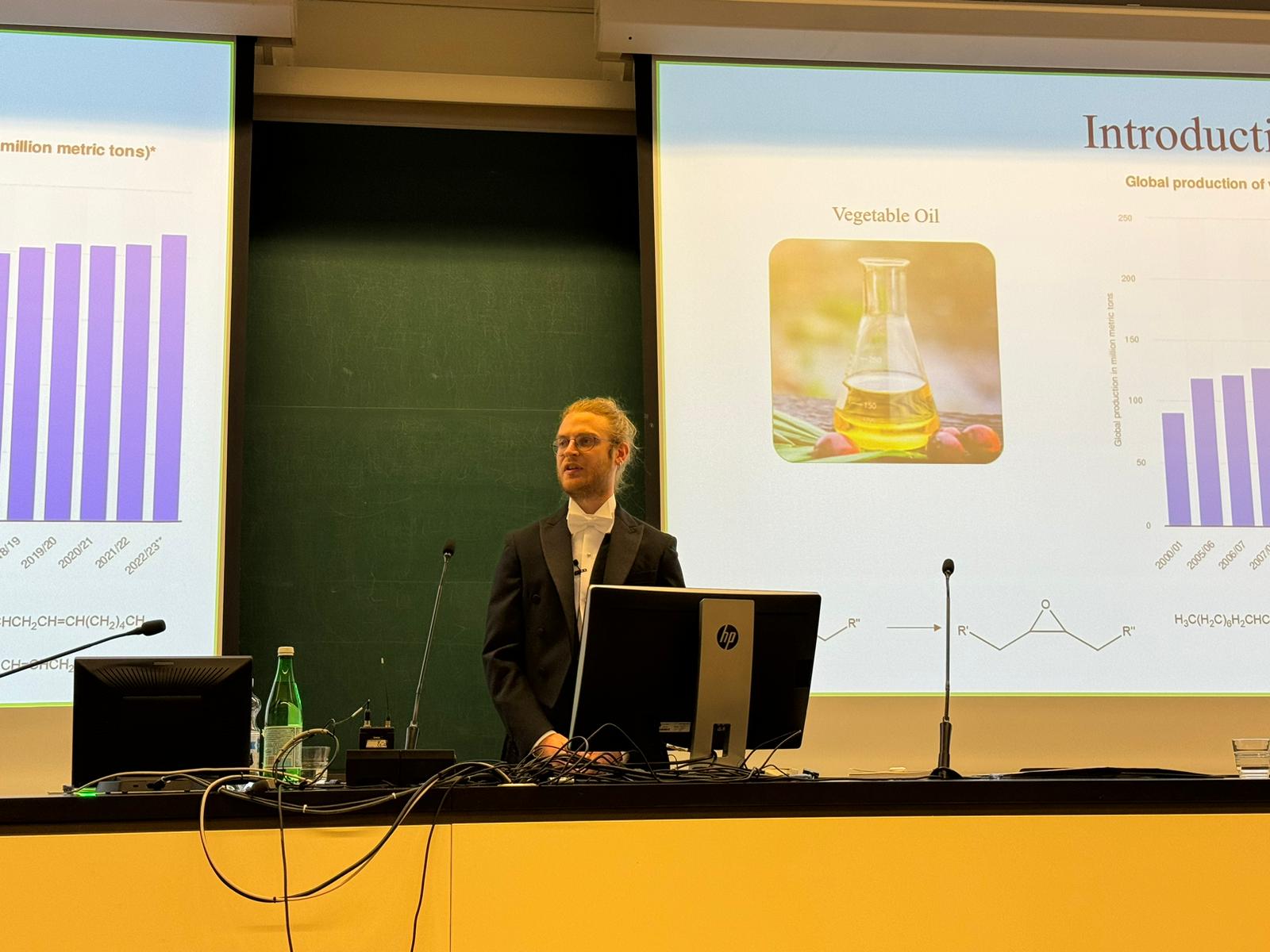Dr Tommaso Cogliano has defended the thesis on the 2nd of February 2024 in cotutelle agreement between University of Naples Federico II and Abo Akademi. The thesis is entitled “Vegetable oils epoxidation : from batch to continuous process”, whose activities were conducted at the Department of Chemical Sciences of UniNa and the Laboratory of Industrial Chemistry and Reaction Engineering at AA and was defended successfully obtaining the highest honour (accepted with distinction). The thesis opponent was Prof. Ing. Habil. Stefan Haase (HTW Dresden).
The thesis can be downloaded here, while the abstract of the thesis can be found below.
Epoxides are a class of compounds characterized by the oxirane functional group, a polar three-terms strain ring composed by two carbon atoms and an oxygen atom. These two properties make the oxirane ring a highly reactive moiety. For this reason, epoxides are important and valuable industrial building blocks for the synthesis of several organic compounds, e.g., di- or polyalcohols, lactones, β-hydroxesters, carbonates etc. In this scenario, Epoxidized Vegetable Oils (EVOs), which are obtained from renewable feedstock, represent noteworthy green platforms to produce chemicals and biomaterials. Epoxides originating from vegetable oils, as well as from derivates of vegetable oils, have already been successfully applied, among others, as plasticizers in the poly(vinyl-chloride) resins, partially replacing phthalates, as intermediates to produce polyurethane, representing an environmentally friendly route compared to the toxic isocyanate process, and as bio-lubricants. Thus, it is possible to understand the ongoing interest, in both academic and industrial research, to this class of value-added chemical compounds. Nevertheless, the industrial synthesis still relies on a semibatch technology, limiting the productivity and selectivity to this platform chemical.
The epoxidation via the Prilezhaev reaction method is the synthesis pathway studied in the present work to produce of epoxides from vegetable oils, both edible and not. The choice of studying this synthesis path is because it is the only one with relevant current industrial application in the epoxidation of this promising feedstock and, more importantly, it belongs to the category of green chemistry and green process technology. The reaction system is composed of two immiscible liquid phases and consecutive reactions take place in the two phases and at the interphase between them. The work was mainly focused in the study of the different reaction steps of the Prilezhaev reaction method in order to efficiently shift to a continuous operation.
A new and fast analytical method based on protonic nuclear magnetic resonance (1H-NMR) was developed in alternative to the traditional volumetric analytical methods to evaluate the double bond conversion and the selectivity to the target product. At first, the system was studied in semibatch operation in the presence of linseed oil to evaluate the reactivity of this highly unsaturated organic substrate. The aim was to develop a biphasic kinetic model able to predict the behavior of organic substrates with different amounts of double bonds, in a backmixed reactor, in terms of conversion, selectivity and, more importantly, thermal profile. Next, the research was focused on the kinetic study of the percarboxylic acid formation and its decomposition. The former reaction, indeed, is the preliminary reaction step before the epoxidation reaction. An important aspect of the reaction system, because of the immiscibility of the two phases, is the partition of the species, especially the oxygen donor. For this reason, the partition coefficients of formic acid, the precursor of the oxygen donor, were experimentally determined. Finally, the epoxidation reaction via the Prilezhaev concept was successfully carried out in a continuous device obtaining satisfactory results in terms of conversion and selectivity adopting milder conditions than the semibatch process.
The epoxidation via the Prilezhaev reaction method is the synthesis pathway studied in the present work to produce of epoxides from vegetable oils, both edible and not. The choice of studying this synthesis path is because it is the only one with relevant current industrial application in the epoxidation of this promising feedstock and, more importantly, it belongs to the category of green chemistry and green process technology. The reaction system is composed of two immiscible liquid phases and consecutive reactions take place in the two phases and at the interphase between them. The work was mainly focused in the study of the different reaction steps of the Prilezhaev reaction method in order to efficiently shift to a continuous operation.
A new and fast analytical method based on protonic nuclear magnetic resonance (1H-NMR) was developed in alternative to the traditional volumetric analytical methods to evaluate the double bond conversion and the selectivity to the target product. At first, the system was studied in semibatch operation in the presence of linseed oil to evaluate the reactivity of this highly unsaturated organic substrate. The aim was to develop a biphasic kinetic model able to predict the behavior of organic substrates with different amounts of double bonds, in a backmixed reactor, in terms of conversion, selectivity and, more importantly, thermal profile. Next, the research was focused on the kinetic study of the percarboxylic acid formation and its decomposition. The former reaction, indeed, is the preliminary reaction step before the epoxidation reaction. An important aspect of the reaction system, because of the immiscibility of the two phases, is the partition of the species, especially the oxygen donor. For this reason, the partition coefficients of formic acid, the precursor of the oxygen donor, were experimentally determined. Finally, the epoxidation reaction via the Prilezhaev concept was successfully carried out in a continuous device obtaining satisfactory results in terms of conversion and selectivity adopting milder conditions than the semibatch process.

